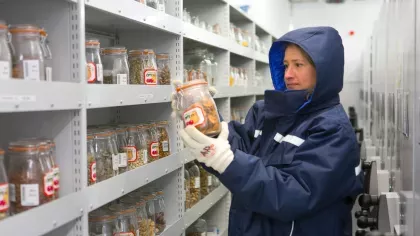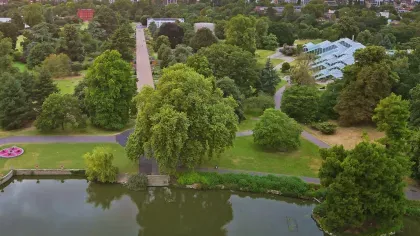20 March 2024
Squirrels v the Millennium Seed Bank: how we collect UK native hazelnuts
Go behind the scenes with the intrepid collectors tracking down seeds for the MSB.

Gathering hazelnuts might sound like a jaunt in the woods, but collecting for the Millennium Seed Bank involves precision timing, x-rays and thousands of seeds. Here’s how UK tree seed field collecting officer Matthew Jeffery and project officer Owen Blake find the right hazel seeds (hazelnuts) and prep them for the deep freeze in our seed vaults.
Q: Why does the Millennium Seed Bank collect hazel seeds?
We need to conserve our native UK trees because they may have unique adaptations to their climatic conditions or resistance to pests and diseases that we don’t yet know about.
Hazel (Corylus avellana) provides food and shelter for insects and animals such as moths, squirrels, dormice and birds. Humans have used the flexible branches for weaving baskets, fences, buildings and plant support structures for thousands of years.


Humans have eaten hazelnuts, also known as cobnuts, almost as long as we’ve lived in Europe: evidence of hazelnut processing dates back to 6000 BC on the island of Colonsay in Scotland!
Through the years hazel has been selectively bred and cultivated to produce larger seeds, which are used to make delicious chocolate hazelnut spreads and pralines.
Our conservation project, Diversity Adaptation and Use, carries on the work of the UK National Tree Seed Collecting Project which ran until 2020. We’re helping to protect the unique genetic information of British tree populations. As well as storing seeds, we send seeds and data to conservation and restoration projects across the nation.
(1).jpg.webp?itok=chrOeWzv)
Q: How do you collect hazel seeds?
Hazel trees flower in the early spring from January to February, with long pendulous male flowers called catkins which produce copious pollen that is dispersed in the wind. Look closely and you can see female flowers on the same branch: they look like little protruding red stars. The hazelnuts eventually form at the base of the female flowers once they’re pollinated.
Hazel seeds will be ripe and ready to collect between September and October, depending on the weather. We look out for the seed’s outer covering changing colour from green to white to light brown to indicate they are ready to pick.
.jpg.webp?itok=NXv1Z27R)
If we are too early, the seed will be under-developed. If we are too late, they may be infested with pests, or we will be competing with hungry squirrels!
Grey squirrels eat unripe hazelnuts, so it can often mean we get a very poor harvest where there are large grey squirrel populations. Red squirrels will only eat ripe hazelnuts. This could be part of why introduced grey squirrels have outcompeted native red squirrels in many areas of the UK.

.jpg.webp?itok=o361YKWP)
Before we collect hazelnuts, we cut open ten individual seeds from the tree to check for empty seed cases or pests (such as insect larvae). We often collect the seeds using a pole pruner, cutting small branches so as not to harm the tree. We only take up to 20% of the available seeds from any one tree on the day. This means there is plenty left for the squirrels and to allow the woodland to regenerate.
Hazelnuts are such big seeds that we collect about a tenth of what we normally would. For other UK tree species we aim to collect about 10,000 seeds at a time: 250 to 1000 seeds from each tree, across ten to twenty individual trees in each population.
For hazelnuts, we only collect about 1,000 seeds per population. One thousand hazelnuts weighs nearly 1kg (2lb), so if we could reach our target of 10,000 it would be very heavy!

Q: How do you choose the right hazel trees?
The UK has 25 tree ‘seed zones’, marked with blue lines on the map. We use this system to help us collect seeds from populations that reflect the wide range of climates and habitats around the UK, and hopefully that means genetic diversity in the plants. We ideally only collect from native populations in ancient woodlands big enough that we can take seeds without damaging their health.
We already have collections of hazel seeds from over 30 populations from 19 counties across England, Scotland, Wales, and Northern Ireland but we are still collecting more.
Hazel has been cultivated so widely that it can be hard to find true wild populations. They might be mixed up with cultivated varieties or other planted species such as the filbert (Corylus maxima), which comes from further East in Europe and Asia. You can tell filbert apart from hazel by its longer tubular husk around the nut.

Q: How do you store hazel seeds?
We take our collections back to the Millennium Seed Bank, where we put them in a dry room at 15% relative humidity. We need to do this before we freeze them so they last longer in storage. Once dry, we use sieves to remove debris and the caps from the top of the seeds.

We also x-ray a sample of our seeds to test for quality. Full seeds look white because water and embryo tissue reflect more x-rays, while empty spaces in the seeds look darker. You can even see if there are insect larvae inside the seeds.
We estimate how many seeds we have by weighing a sample, counting the seeds in it and multiplying by the total weight of the collection - adjusting depending on the percentage of full seeds we saw in the x-ray.
Finally, we put the hazel seeds in airtight storage jars and place them in the Millennium Seed Bank vault freezers at -20°C.

Q: How long will the seeds last in the vault?
Until recently, scientists weren’t sure that hazel seed would survive the pre-freeze drying at all. We now know that it can, but we still don’t know exactly how long a hazel seed can last in -20°C storage. It will only be revealed over time, as periodic germination tests on our collections show us just how many seeds are able to survive.
Germination tests involve taking a few seeds out of storage and planting them to see how many will sprout. We do this every few years and it’s the best way for us to understand how long different seeds are likely to last in the vault.

We store small backups of many of our hazel collections in cryogenic vessels, to explore the best storage options and protect our collection for the long term. These are much colder than the MSB at -190°C. The seed is frozen very quickly and in theory, it should last longer under these conditions.
We can’t do this for all our collections because cryogenic storage is vastly more expensive to run with a lot less space compared to the conventional storage vaults, and a collection of hazelnuts can take up as much space as 100 other smaller-seeded species.
Find out more about the Diversity, Adaptation and Use tree seed collecting project.


.jpg.webp?itok=STOrmosg)
